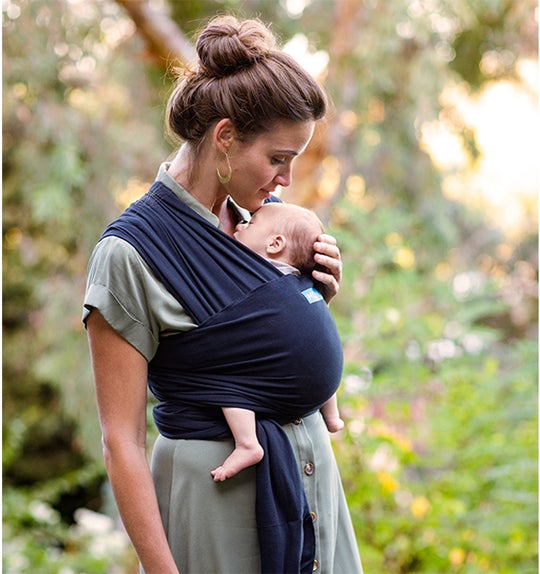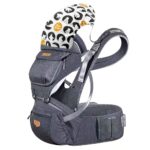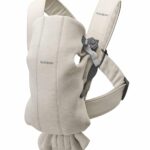Babywearing for Newborns promotes bonding and supports development . It reduces crying and aids in parental responsiveness.
Embracing the practice of babywearing offers a multitude of benefits for both the infant and the caregiver. It allows for a deep connection to form as babies feel the warmth and hear the heartbeat of their parents, simulating the comfort of the womb.
This close contact not only fosters a secure attachment but also significantly decreases the likelihood of postpartum depression by keeping the baby in close proximity to the caregiver. Newborns benefit through improved sleep patterns, reduced crying, and enhanced learning as they observe the world from a safe vantage point. Parents gain from the convenience of hands-free mobility, making daily tasks more manageable. Babywearing is a nurturing tool that encourages a harmonious transition for newborns adjusting to life outside the womb while providing caregivers with a practical solution to meet the demands of modern parenting.

The Essence Of Babywearing for Newborns
The essence of babywearing goes beyond convenience. It fosters a unique connection between the parent and the newborn. This practice not only provides comfort but also supports early developmental milestones in a nurturing environment.
Emotional Benefits For Infant And Parent
Babywearing strengthens the bond between parent and baby. This close contact helps the baby feel more secure and loved.
- Reduces crying and fussiness
- Increases calmness, making babies happier
- Encourages parental responsiveness to baby’s cues
Parents also feel a greater sense of confidence and connection with their child. This emotional sync can reduce the risk of postpartum depression.
Physical Proximity And Mental Development
Keeping your baby close through babywearing supports their physical and mental growth. The constant physical contact stimulates brain development.
| Aspect | Benefit |
|---|---|
| Physical Growth | Supports natural posture and spine alignment. |
| Cognitive Development | Enhances language skills as babies are exposed to more conversations. |
| Social Development | Increases awareness by being at adult eye level, seeing the world as parents do. |
This method also promotes better sleep patterns and can help reduce common newborn issues like colic and reflux.
Promoting Parent-infant Attachment
Babywearing is more than just a method to transport a child. It is a path to creating a deep, nurturing bond between parent and infant. This closeness is critical in the early months of life, offering numerous benefits for both the baby and the caregiver.
Strengthening The Parental Bond
The act of holding a baby close in a wrap or sling creates an intimate environment that mirrors the security of the womb. This physical closeness releases oxytocin, often referred to as the ‘love hormone’, which fosters a sense of trust and attachment.
- Enhances calmness
- Facilitates emotional connection
- Supports early communication
Responsive Parenting And Baby’s Needs
Parents who wear their babies tend to become finely attuned to their child’s cues and gestures. This heightened awareness enables them to respond more quickly to their baby’s needs, often before crying begins.
| Responsive Actions | Benefits for Baby |
|---|---|
| Quick feeding | Less stress |
| Timely diaper changes | Comfort |
| Consistent soothing | Trust development |

Supporting Proper Hip Development
Babywearing encourages healthy hip positioning, which is critical for newborns. It allows the baby’s legs to spread apart naturally, promoting the development of the hip joint. This is particularly important during the first six months when the hip’s soft cartilage is developing into bone.
- Maintains the “M” shape posture, which fosters optimal hip development.
- Supports the thighs and keeps the hips in a stable position.
- Can reduce the risk of developmental dysplasia of the hip (DDH).
Preventing Flat Head Syndrome
Reduces the pressure on the back of the baby’s head, helping to prevent positional plagiocephaly, commonly known as Flat Head Syndrome. When a baby is carried in a wrap or sling, they are not lying flat against a hard surface, which can cause the skull to become misshapen.
| Babywearing Position | Benefits |
|---|---|
| Upright | Evenly distributes pressure, allowing natural head shaping. |
| Varied | Changes points of pressure on the head throughout the day. |

Credit: onyababy.com
Alleviating Common Infant Discomforts
Babywearing is more than just a way to carry your baby. It’s a tool that can help ease the common discomforts many infants experience. From unsettled tummies to disrupted sleep, babywearing offers a natural approach to soothe and comfort your little one.
Soothing Colic and Reducing Reflux
Soothing Colic And Reducing Reflux
Holding your baby close in a carrier can significantly soothe colic. The upright position helps manage reflux, a condition causing spit-up and discomfort. The gentle rocking motion and warmth from your body provide a calming effect.
- Keeps baby upright, easing digestion
- Reduces crying spells linked to colic
- Encourages bonding, which can naturally soothe baby
Enhancing Sleep Patterns
Enhancing Sleep Patterns
Babywearing doesn’t just make for easier days; it also leads to better nights. Carriers mimic the rhythmic movements babies felt in the womb. This familiarity can help them fall asleep more quickly and stay asleep longer.
Cognitive And Language Development
Babywearing, a practice that involves carrying a baby close in a sling or carrier, supports early cognitive and language development. As newborns engage with their environment from the security of a carrier, they experience the world in a way that promotes learning and communication skills.
Stimulating Baby’s Learning
Stimulating a baby’s senses is key to their cognitive growth. When worn, babies have a front-row seat to the caregiver’s daily activities, providing a rich learning environment.
- Visual stimulation from varying sights
- Auditory exposure to conversations and sounds
- Tactile experiences through closeness and movement
This exposure helps to wire the brain for further learning and problem-solving.
Language Acquisition Through Closeness
The proximity between baby and caregiver in babywearing enhances language acquisition. Babies closely observe facial expressions and participate in language-rich environments.
| Aspect | Benefit |
|---|---|
| Listening | Babies hear constant speech patterns and sounds. |
| Speaking | Caregivers are more likely to talk directly to their baby. |
| Social Interaction | Babies engage in social cues and non-verbal communication. |
This close interaction encourages earlier vocalization and a better understanding of language.
Benefits For Maternal Well-being
Babywearing offers numerous benefits, not just for the little ones, but for mothers as well. It’s a practice that can enhance the postpartum experience, making it more joyful and less stressful. Below, we explore how babywearing positively affects maternal well-being.
Easing Postpartum Depression
Many new mothers face the challenge of postpartum depression. Babywearing can be a powerful tool in easing these symptoms. The close contact with the baby releases oxytocin, often called the ‘love hormone’, which can improve mood and reduce stress.
- Increases positive hormonal feedback
- Reduces feelings of anxiety and sadness
- Provides comfort, knowing the baby is safe and close
Facilitating Breastfeeding And Bonding
Babywearing simplifies breastfeeding by keeping the baby close and accessible. This encourages frequent feedings and helps establish a strong breastfeeding relationship. Additionally, the physical closeness fosters a deep emotional bond between mother and child.
| Breastfeeding Benefits | Bonding Benefits |
|---|---|
| Convenient feeding position | Enhanced emotional connection |
| Increased milk supply | Improved baby’s sense of security |
Practical Perks Of Babywearing
Babywearing is not just about keeping your baby close. It’s about making life easier for new parents. With a snugly wrapped baby, you can move freely and tackle daily tasks. Let’s explore the practical benefits that babywearing offers.
Hands-free Convenience
Imagine holding your baby and still having both hands free. Babywearing makes this possible. You can cook, clean, or even shop while your baby stays safe and content.
- Multi-task: Accomplish chores without missing a beat.
- Bonding: Keep your baby close while staying productive.
Navigating Public Spaces With Ease
Strollers can be bulky. With babywearing, you move through crowds and narrow aisles with ease. No more struggling with doors or stairs.
| Place | With Stroller | With Baby Carrier |
|---|---|---|
| Stores | Difficult | Easy |
| Public Transport | Challenging | Convenient |

Optimizing Babywearing Duration
Babywearing offers numerous benefits for both newborns and parents. It promotes bonding, reduces crying, and supports healthy development. To maximize these advantages, it’s essential to optimize the duration of babywearing.
Determining Ideal Daily Use
Understanding the right amount of daily babywearing is key. It varies based on the baby’s age, weight, and developmental stage. Newborns often enjoy being worn for several hours, especially in the first few months.
- Start with short intervals and observe baby’s response.
- Gradually increase time as baby appears comfortable and content.
- Monitor for any signs of overstimulation or discomfort.
- Ensure frequent breaks for feeding, diaper changes, and cuddling.
Balancing Baby’s Needs And Parent Comfort
Parents should also consider their own comfort and physical limits. Proper babywearing techniques are vital for avoiding fatigue and maintaining good posture.
| Time | Baby’s Needs | Parent Comfort |
|---|---|---|
| Morning | Alert and curious | Rested and energetic |
| Afternoon | May need soothing | Watch for fatigue |
| Evening | Preparing for sleep | Plan for shorter duration |
Choose a comfortable carrier that supports the baby’s hips and back. Adjust straps for a snug fit to distribute weight evenly. Alternate the carrying parent to prevent strain.
Safety Considerations In Babywearing
While babywearing offers numerous benefits, it’s vital to practice it safely. Parents and caregivers must understand how to reduce risks effectively. Safety ensures the baby’s well-being and provides peace of mind during babywearing.
Reducing Risks Of Suffocation And Falls
Proper positioning is critical to prevent suffocation. Babies should be close enough to kiss, with their face visible and nose and mouth clear. A snug fit prevents slumping, which can restrict breathing.
Preventing falls means checking the carrier’s integrity before each use. Secure fastenings and correct fit are non-negotiable. Always keep one hand on the baby when bending over to maintain balance and support.
Ensuring Optimal Hip Development
Babywearing can support hip health with the right carrier. The carrier should offer ergonomic support, positioning the baby’s legs in an ‘M’ shape. This position promotes natural hip development and reduces the risk of hip dysplasia.
Regular check-ups with a pediatrician can monitor hip development. This is crucial for infants with a family history of hip issues or those born with hip instability.
The Role Of Baby Carriers
Baby carriers play a crucial role in babywearing. They keep newborns close, promoting a strong bond and providing comfort.
Choosing The Right Carrier
Choosing the right carrier is vital for comfort and safety. Here are some tips:
- Check the fabric: Ensure it’s breathable and suitable for all seasons.
- Look for adjustability: This makes the carrier flexible as your baby grows.
- Consider support: A good carrier offers strong support for the baby’s back and hips.
- Read reviews: Other parents’ experiences can guide your choice.
Adjusting For Baby’s Growth
As babies grow, adjusting the carrier is essential. Follow these steps:
- Loosen the straps: Give more space as your baby gets bigger.
- Reposition the base: Keep baby’s hips in a natural, comfortable position.
- Regular checks: Always ensure the carrier feels secure and comfortable.
Regular adjustments keep the carrier safe and comfy as your baby grows.
Social And Psychological Impacts
The Social and Psychological Impacts of babywearing are profound. This practice not only keeps babies close but also fosters emotional and social development from an early age.
Fostering A Secure Base For Exploration
Babywearing creates a safe environment for newborns. Being close to a parent provides a base of security. From here, babies can explore the world around them. This secure feeling helps in developing trust and attachment.
Building Social Awareness
Carried babies are at eye-level with adults and can study facial expressions, communication styles, and social interactions closely. This exposure significantly boosts their social and emotional intelligence early in life.
| Aspect | Impact |
|---|---|
| Emotional Security | Increases feelings of safety and comfort. |
| Social Skills | Enhances understanding of social cues. |
Babywearing Across Cultures
Babywearing Across Cultures explores the rich traditions and current trends of keeping infants close. This practice has been a cornerstone in nurturing babies across the globe. From the snow-capped mountains of Peru to the bustling streets of Tokyo, babywearing is a universal language of love and care. Let’s delve into how this age-old custom has been woven into the fabric of different societies and how it continues to evolve.
Traditional Practices Worldwide
The art of babywearing is deeply rooted in history, transcending geographical boundaries and cultural divides. Here are some fascinating examples:
- African Kanga: In Africa, mothers use colorful kangas to secure their babies on their backs, allowing them to work hands-free.
- Native American Cradleboards: These wooden frames provide support and protection while integrating ornate designs and symbols.
- Japanese Onbuhimo: A ringless sling, the onbuhimo is designed for toddlers, emphasizing ease of use and comfort.
Modern Adaptations And Trends
Babywearing has adapted to modern life, blending traditional techniques with new innovations. Today’s parents have a myriad of options to choose from:
| Type | Features |
|---|---|
| Soft-Structured Carriers | Adjustable straps, ergonomic support, multiple positions |
| Wraps | Flexible fabric, customizable fit, skin-to-skin contact |
| Slings | One-shouldered wear, quick to use, compact design |
The resurgence of babywearing is more than a trend; it’s a return to the basics of infant care. Modern carriers now come with enhanced safety features, stylish designs, and materials that cater to the active parent. These contemporary adaptations respect tradition while meeting the needs of today’s families.
Community And Support
Babywearing brings more than just comfort and closeness; it fosters a vibrant community. New parents often find support and friendship through shared experiences. Let’s explore how you can connect with other babywearing enthusiasts.
Finding Local Babywearing Groups
Local groups offer face-to-face interactions and hands-on help. They provide safe spaces to learn and share different babywearing techniques. You can find these groups at:
- Community centers
- Children’s stores
- Local libraries
These groups often hold regular meetups, workshops, and events. They can help troubleshoot issues and offer personalized advice.
Online Resources And Forums
If in-person gatherings aren’t an option, online forums and social media groups are invaluable resources. They offer:
- 24/7 support
- Reviews on different carriers
- Advice from experienced babywearers
Websites and online communities can connect you with global babywearing cultures. They help you stay informed about the latest trends and products.

Addressing Common Concerns
Many new parents embrace babywearing for its numerous benefits, but some may feel hesitant due to myths and criticism. This section aims to address those concerns and provide clarity on the practice of babywearing.
Debunking Babywearing Myths
Babywearing is a tradition practiced across the globe with positive impacts on newborns. Despite this, several myths can cause unnecessary worry. Let’s set the record straight:
- Myth: Babywearing is tiring. Truth: It distributes the baby’s weight, making it easier to carry them.
- Myth: It spoils the baby. Truth: Babies feel secure, fostering independence later on.
- Myth: It hinders motor development. Truth: It encourages muscle growth and balance.
Responding To Criticism And Doubts
Parents sometimes face doubts about babywearing. Here’s how to respond:
- Concern: “Isn’t it unsafe?” Response: When done correctly, it’s safe and comforting.
- Concern: “Will it affect the baby’s posture?” Response: Ergonomic carriers support proper posture.
- Concern: “What about the baby’s hips?” Response: Proper positioning ensures healthy hip development.
Understanding the facts helps parents confidently enjoy the bonding and practicality of babywearing.
Personal Stories And Testimonials
Personal stories and testimonials bring the benefits of babywearing to life. They show how this practice creates lasting bonds and eases the lives of new parents. Read on to discover real stories that highlight the warmth and practicality of babywearing.
Real-life Babywearing Experiences
Parents across the globe share tales of calm infants and hands-free convenience. One mother, Sarah, tells of walks through Austin’s Zilker Park with her baby snuggled close. Her newborn sleeps peacefully, lulled by her heartbeat.
- John, a dad, finds multitasking easier with a carrier.
- Emma, a new mom, notes less crying and more bonding.
- Olivia sees her baby’s curiosity grow during daily routines.
The Impact On Family Dynamics
Babywearing shifts family roles positively. It allows siblings to interact more with the newborn. Grandparents find it easier to hold the baby without arm strain. Families report a stronger sense of unity.
| Family Member | Experience |
|---|---|
| Mom | Feels more connected to the baby. |
| Dad | Enjoys being a part of the caregiving process. |
| Siblings | Can play and interact while mom or dad carries the baby. |
Frequently Asked Questions
Is Baby Wearing Good For A Newborn?
Yes, babywearing is beneficial for newborns as it fosters bonding, supports breastfeeding, and aids in emotional and cognitive development.
Does Baby Wearing Help With Development?
Yes, babywearing supports developmental milestones by promoting secure attachment, enhancing social and language skills, and encouraging physical growth through proper hip support.
How Many Hours A Day Should You Baby Wear?
Aim for 1-3 hours of babywearing per day to benefit both you and your baby.
Is It Good To Carry A Baby Around All The Time?
Carrying a baby frequently can be beneficial, promoting bonding and development, but it’s important to allow for independent play too.
What Are The Top Benefits Of Babywearing?
Babywearing fosters closeness, enhancing bonding and security between parent and child. It also supports breastfeeding and reduces crying by offering constant warmth and comfort.
Conclusion
Embracing babywearing yields a cascade of perks for both newborns and parents. It fosters early bonding, eases infant distress, and supports development. Parents gain confidence as they learn to interpret their baby’s cues. This nurturing practice proves invaluable for the family unit.
Embrace babywearing for a happier, healthier parenting journey.







